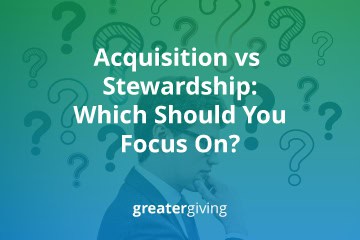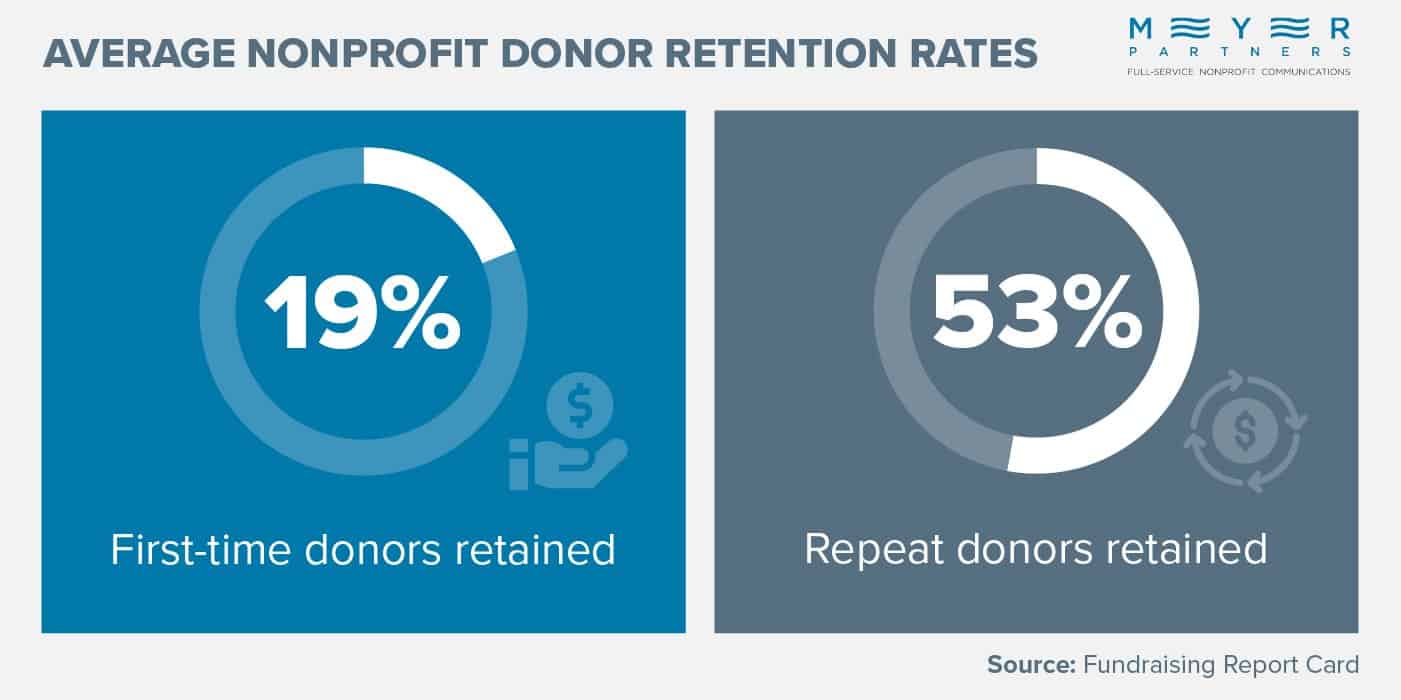
Veteran nonprofit professionals know there’s no one true way to fundraise. Instead, you must constantly adjust your strategy to align with changing organizational priorities, donor preferences, and industry trends. Pouring money into donor acquisition may work for one campaign, while another requires nuanced stewardship strategies to strengthen existing donor relationships.
In general, we recommend focusing on stewardship rather than acquisition because your existing donors provide more value to your nonprofit in the long run. After all, less than a fifth of first-time donors will ever give a second gift, which makes nurturing the relationships you already have much more cost-effective.
However, both acquisition and stewardship are essential to your fundraising strategy at different times. Use these questions to determine which one to focus on for specific campaigns, communication strategies, and initiatives.
Who is your target audience?
The answer to this question may seem straightforward (i.e., “We’re targeting new donors, so clearly our focus is donor acquisition” or “This email goes out to monthly donors who we want to steward”), but narrowing down your audience further can help you create nuanced goals and strategies.
For example, you might plan to send out direct mail thank-yous to everyone who participated in a recent fundraising drive. With this information, you might assume the goal is donor stewardship, but in reality, this audience could also include:
- Volunteers who have never donated
- People who took advocacy actions during the campaign
- Prospective donors who attended a free event
- Social media followers who shared your posts
Since all of these supporters have the potential to become new donors, acquisition could be a worthwhile goal here. Instead of writing one letter that only aims to steward existing donors, you could create separate messages for each group. To boost donor acquisition, your messages to these supporters should include information about how they can deepen their involvement and explain why the campaign needs more support.
If you aren’t sure who your target audience is for a particular campaign or message, Getting Attention recommends analyzing past audience data to identify key characteristics, such as involvement history and giving behaviors. Use this data to create donor segments that are relevant to your goals.
How healthy are your donor retention rates?
Donor retention rates measure how many donors give consecutively from one time period to the next without lapsing. Your donor retention rates are a clear indicator of the success of your stewardship strategies.
Use your donor database to assess your retention rates for new and repeat supporters. Then, compare them to the average retention rates for nonprofits. The latest metrics from Fundraising Report Card’s Benchmarks show that:

- 19% of first-time donors are retained on average.
- 53% of repeat donors are retained on average.
If your donor retention rates are below average or your usual retention rates, evaluate your current stewardship practices. While donors lapse for a number of reasons, several relate to how you communicate with and steward them. For instance, lapsed donors may feel unappreciated, out of the loop, or like their contributions don’t make a difference.
Start improving your stewardship practices by digging deeper into your data to identify patterns in donor behavior, such as actions usually taken before donor lapse or what communications specific supporter groups respond well to. Try out new stewardship strategies, always monitoring your engagement data and retention rates to gauge their effectiveness.
What is your average donor lifetime value (LTV)?
Along with donor retention, consider the fundraising revenue that donors contribute in the long term. That’s where measuring donor lifetime value (LTV) comes in.
According to Meyer Partners, donor LTV is “a predicted measurement of how much gross revenue you can expect to be contributed from a donor who has been in your files for at least five years.” The formula for calculating LTV is:
[Average number of years donors stay involved with your nonprofit] x [Average donation amount] x [Average donation frequency] = Donor LTV.
If your average donor LTV is low, this indicates that you need to prioritize donor stewardship. Create stewardship plans to show donors you care about them as people and want to get to know them better. As part of your stewardship efforts, conduct prospect research to identify donors with the potential to give at higher levels. Improve these relationships with personalized outreach to eventually ask them to upgrade their support.
A low average LTV could also mean you’re not targeting the right new donors for acquisition. If you decide to focus on acquisition for the time being, refine your target audience by analyzing existing donor data and targeting prospects with similar characteristics to your current audience but increased financial capacity. This ensures your new donors are valuable to your nonprofit long-term.
Do you have donor stewardship plans in place?
If you don’t have clearly outlined plans to improve relationships with donors after they give, take the time to formulate these plans now.
Establish a core stewardship framework or matrix that defines how, when, and how often you’ll communicate with new and existing donors beyond fundraising appeals. These communications could include thank-you messages, updates, invitations to involvement opportunities, etc.
Plan out specific strategies to use for donors across giving and engagement levels. For example, you might add the following segments to your stewardship matrix and engage with each group in relevant, appropriate ways:
- First-time donors: Depending on the size of their gifts, send a welcome email series or welcome packet. Share information about your organization and consider sending a survey to get to know them better.
- Recurring donors: Monthly or other recurring donors might appreciate regular program updates, invitations to fundraising and donor appreciation events, or small gifts of branded merchandise.
- Engaged mid-level donors: Encourage these donors to upgrade their support by inviting them to in-person activities, giving them occasional phone calls, and publicly recognizing their support.
- Major donors: Each of your major donors should receive special, personalized attention. Invite them to VIP events, one-on-one meetings, and other opportunities that align with their unique charitable interests.
Individual stewardship efforts should be personalized whenever possible, but having a baseline strategy serves as a good foundation for your efforts. Once you’ve solidified your stewardship plans and your team knows how to carry them out, you can redirect your attention to acquisition if needed.
Your organization’s priorities will shift often, and these questions can guide valuable discussions and decisions about your fundraising strategy. If you want more support, consider partnering with a fundraising consultant for tailored advice. These experts can analyze your entire communications strategy, determine which areas need the most attention, and provide data services and marketing support to help you improve performance in each area.
